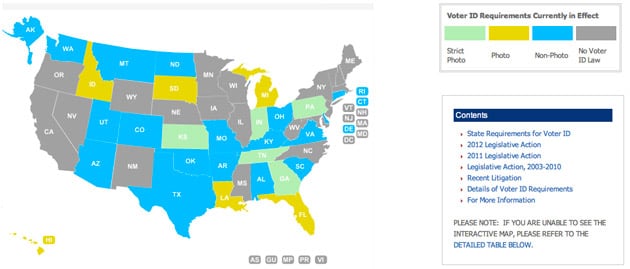Table 2: Details of Voter Identification Requirements
|
State
|
Requirement
|
Acceptable Forms of ID
|
Voters Without ID
|
|
§17-9-30
NOTE: AL's new photo ID law is scheduled to take effect for the 2014 primary election. It also requires preclearance by the USDOJ.
|
Existing Law:
Each elector shall provide identification to an appropriate election official prior to voting.
New Law:
Each elector shall provide valid photo identification to an appropriate election official prior to voting. |
Existing Law:
-
Government-issued photo ID
-
U.S. passport
-
U.S. military ID
-
Employee ID card with photo
-
Alabama college/university ID with photo
-
Alabama hunting or fishing license
-
Alabama gun permit
-
FAA-issued pilot's license
-
Birth certificate (certified copy)
-
Social security card
-
Naturalization document
-
Court record of adoption or name change
-
Medicaid or Medicare card
-
Electronic benefits transfer card
-
Utility bill, bank statement, government check, paycheck or government document showing name and address of voter
New Law:
-
Valid Alabama driver's license or non-driver ID card
-
Valid photo voter ID card or other valid ID card issued by any
state or the federal government , as long as it contains a photo
-
Valid U.S. passport
-
Valid government employee ID card with a photo
-
Valid student or employee ID card issued by a college or university in the state, provided it includes a photo
-
Valid U.S. military ID card containing a photo
-
Valid tribal ID card containing a photo
|
Existing Law:
Vote a challenged or provisional ballot or vote, if s/he is
identified by two poll workers as an eligible a voter on the poll list,
and both poll workers sign the voting sign-in register by the voter’s
name.
New Law:
Vote a provisional ballot or vote a regular ballot if s/he is
identified by two election officials as an eligible voter on the poll
list, and both election workers sign a sworn affidavit so stating. |
|
§15.15.225
|
Before being allowed to vote, each voter shall exhibit to an election official one form of identification. |
-
Official voter registration card
-
Driver's license
-
Birth certificate
-
Passport
-
Hunting or fishing license
-
Current utility bill, bank statement, paycheck, government
check or other government document with the voter’s name and address
|
An election official may waive the identification requirement
if the election official knows the identity of the voter. A voter who
cannot exhibit a required form of identification shall be allowed to
vote a questioned ballot. |
|
§16-579(A)
|
Every qualified elector shall present one form of
identification that bears the name, address and photograph of the
elector or two different forms of identification that bear the name and
address of the elector. |
-
Valid Arizona driver's license
-
Valid Arizona non-driver identification
-
Tribal enrollment card or other form of tribal identification
-
Valid U.S. federal, state or local government issued identification
-
Utility bill dated within 90 days of the election
-
Bank or credit union statement dated within 90 days of the election
-
Valid Arizona vehicle registration
-
Indian census card
-
Property tax statement
-
Vehicle insurance card
-
Recorder’s Certificate
|
An elector who does not provide the required identification
shall receive a provisional ballot. Provisional ballots are counted only
if the elector provides identification to the county recorder by 5pm on
the fifth business day after a general election that includes an
election for federal office, or by 5pm on the third business day after
any other election. |
|
§7-5-305
|
Election officials shall request the voter to provide identification |
-
Current and valid photo ID
-
Copy of a current utility bill, bank statement, government
check, paycheck, or other government document that shows the name and
address of the voter
|
If a voter is unable to provide this identification, the
election official shall indicate on the precinct voter registration list
that the voter did not provide identification. Following each election,
the county board of election commissioners may review the precinct
voter registration lists and may provide the information of the voters
not providing identification at the polls to the prosecuting attorney,
who may investigate possible voter fraud. |
|
§1-1-104(19.5) and 1-7-110
|
Any eligible elector desiring to vote shall show his or her identification as defined in section 1-1-104 (19.5). |
-
Colorado driver's license
-
CO Dept. of Revenue ID card
-
U.S. passport
-
Employee ID card with photo issued by the U.S. government, CO state government, or political subdivision of CO
-
Pilot’s license
-
U.S. military ID with photo
-
A copy of a current utility bill, bank statement, government
check, paycheck, or other government document that shows the name and
address of the elector
-
Medicare or Medicaid card
-
Certified copy of birth certificate
-
Certified documentation of naturalization
|
An eligible elector who is unable to produce identification may cast a provisional ballot.
The designated election official shall attempt to verify that
an elector who cast a provisional ballot is eligible to vote. The
designated election official or designee shall complete the preliminary
verification of the elector's eligibility to vote before the ballot is
counted. (§1-8.5-105) |
|
§9-261
|
Each elector shall present identification
|
-
Social security card
-
Any other preprinted form of identification which shows the
elector's name and either the elector's address, signature or photograph
|
Elector shall, on a form prescribed by the Secretary of the
State, write the elector's residential address and date of birth, print
the elector's name and sign a statement under penalty of false statement
that the elector is the elector whose name appears on the official
checklist. |
|
Tit. 15, §4937
|
A voter, upon entering the room where an election is being
held, shall announce his or her name and address and provide proof of
identity |
-
Photo ID
-
Utility bill
-
Paycheck
-
Any government document with voter’s name and address
|
In the event the voter does not have proof of identity with
them, he or she shall sign an affidavit of affirmation that he or she is
the person listed on the election district record. |
|
§101.043
|
The clerk or inspector shall require each elector, upon
entering the polling place, to present a current and valid picture
identification as provided in s. 97.0535(3)(a). If the picture
identification does not contain the signature of the voter, an
additional identification that provides the voter's signature shall be
required. |
-
Florida driver's license
-
Florida ID card issued by the Dept. of Highway Safety and Motor Vehicles
-
U.S. passport
-
Debit or credit card
-
Military identification
-
Student identification
-
Retirement center identification
-
Neighborhood association ID
-
Public assistance identification
|
If the elector fails to furnish the required identification,
the elector shall be allowed to vote a provisional ballot. The
canvassing board shall determine the validity of the ballot by
determining whether the elector is entitled to vote at the precinct
where the ballot was cast and that the elector had not already cast a
ballot in the election.
Florida uses signature matching: the voter signs the
provisional ballot envelope. That signature is compared to the signature
in the voter registration records. If they match, the ballot is
counted.
|
|
§21-2-417
|
Each elector shall present proper identification to a poll
worker at or prior to completion of a voter's certificate at any polling
place and prior to such person's admission to the enclosed space at
such polling place. |
-
Georgia driver’s license, even if expired
-
ID card issued by the state of Georgia or the federal government
-
Free voter ID card issued by the state or county
-
U.S. passport
-
Valid employee ID card containing a photograph from any
branch, department, agency, or entity of the U.S. Government, Georgia,
or any county, municipality, board, authority or other entity of this
state
-
Valid U.S. military identification card
-
Valid tribal photo ID
|
If you show up to vote and you do not have one of the
acceptable forms of photo identification, you can still vote a
provisional ballot. You will have up to three days after the election
to present appropriate photo identification at your county registrar's office in order for your provisional ballot to be counted.
|
|
§11-136
|
Every person shall provide identification if so requested by a precinct official. |
Pollworkers request photo ID with a signature. Acceptable types of ID are not specified by law.
|
If the voter has no identification, the voter will be asked to
recite his/her date of birth and residence address to corroborate the
information provided in the poll book. |
Idaho
§34-1106(2), 34-1113, 34-1114 |
Each elector shall show a valid photo identification or personal identification affidavit. |
-
Idaho driver's license
-
Idaho ID card
-
Passport
-
ID card, including a photo, issued by an agency of the U.S. government
-
Tribal ID card, including a photograph
-
Student ID card, including a photograph, issued by a high
school or accredited institution of higher education within the state of
Idaho
|
A voter may complete an affidavit in lieu of the personal
identification. The affidavit shall be on a form prescribed by the
secretary of state and shall require the voter to provide the voter's
name and address. The voter shall sign the affidavit. Any person who
knowingly provides false, erroneous or inaccurate information on such
affidavit shall be guilty of a felony. |
|
§3-5-2-40.5, 3-10-1-7.2 and 3-11-8-25.1
|
A voter who desires to vote an official ballot at an election shall provide proof of identification.
A voter who votes in person at a precinct polling place that is
located at a state licensed care facility where the voter resides is
not required to provide proof of identification before voting in an
election. |
Specific forms of ID are not listed in statute. ID must be
issued by the state of Indiana or the U.S. government and must show the
following:
-
Name of individual to whom it was issued, which must conform to the individual's registration record
-
Photo of the person to whom it was issued
-
Expiration date (if it is expired, it must have an expiration
date after the most recent general election; military IDs are exempted
from the requirement that ID bear an expiration date)
-
Must be issued by the United States or the state of Indiana
|
Voters who are unable or decline to produce proof of
identification may vote a provisional ballot. The ballot is counted only
if (1) the voter returns to the election board by noon on the Monday
after the election and: (A) produces proof of identification; or (B)
executes an affidavit stating that the voter cannot obtain proof of
identification, because the voter: (i) is indigent; or (ii) has a
religious objection to being photographed; and (2) the voter has not
been challenged or required to vote a provisional ballot for any other
reason. |
Kansas
§25-2908, 25-1122, 25-3002, and 8-1324(g)(2) |
Each person desiring to vote shall provide a valid form of
identification. The following are exempted from the ID requirement:
-
persons with a permanent physical disability that makes it
impossible for them to travel to obtain voting identification and who
have permanent advance voting status
-
members of the merchant marine and uniformed service
members who are on active duty and absent from the county on election
day, as well as their spouses and dependents
-
any voter whose religious beliefs prohibit photographic identification
|
The following forms of identification are valid if they contain
the name and photograph of the voter and have not expired. Expired
documents are valid if the bearer is aged 65 or older.
-
Driver's license issued by Kansas or another state
-
State identification card
-
Government-issued concealed carry handgun or weapon license
-
U.S. passport
-
Employee badge or identification document issued by a government office or agency
-
Military ID
-
Student ID issued by an accredited postsecondary institution in Kansas
-
Government-issued public assistance ID card
|
A voter who is unable or refuses to provide current and valid identification may vote a provisional ballot.
In order to have his or her ballot counted, the
voter must provide a valid form of identification to the county election
officer in person or provide a copy by mail or electronic means before
the meeting of the county board of canvassers.
|
|
§117.227
|
Election officers shall confirm the identity of each voter by personal acquaintance or by a document. |
-
Driver’s license
-
Social Security card
-
Credit card
|
When the officers of an election disagree as to the
qualifications of a voter or if his right to vote is disputed by a
challenger, the voter shall sign a written oath as to his qualifications
before he is permitted to vote. |
|
§18:562
|
Each applicant shall identify himself, in the presence and view
of the bystanders, and present identification to the commissioners. |
-
Louisiana driver’s license
-
Louisiana special ID card
-
Other generally recognized picture identification
|
If the applicant does not have identification, s/he shall sign
an affidavit to that effect before the commissioners, and the applicant
shall provide further identification by presenting his current
registration certificate, giving his date of birth or providing other
information stated in the precinct register that is requested by the
commissioners. However, an applicant that is allowed to vote without
the picture identification required by this Paragraph is subject to
challenge as provided in R.S. 18:565. |
|
§168.523
|
Each voter must show a photo ID or sign an affidavit attesting
that he or she is not in possession of photo identification. |
-
Michigan driver's license
-
Michigan personal identification card
A voter who does not possess either of the above may show any of the following, as long as they are current:
-
Driver's license or personal identification card issued by another state
-
Federal or state government-issued photo ID
-
U.S. passport
-
Military ID with photo
-
Student ID with photo -- from a high school or accredited institution of higher education
-
Tribal ID with photo
|
An individual who does not possess, or did not bring to the
polls, photo ID, may sign an affidavit and vote a regular ballot. |
Mississippi
§23-15-563
Mississippi's voter ID law requires USDOJ pre-clearance before it can take effect. |
An elector who votes in person in a primary or general election
shall present government-issued photo identification before being
allowed to vote. Voters who live and vote in a state-licensed care
facility are exempt. |
Mississippi's new constitutional amendment simply says
"government-issued photo identification." Implementing legislation
and/or administrative rules will be necessary to define precisely what
this means. |
An individual without ID can cast an affidavit ballot which
will be counted if the individual returns to the appropriate circuit
clerk within five days after the election and shows government-issued
photo ID.
Voters with a religious objection to being photographed may
vote an affidavit ballot, which will be counted if the voter returns to
the appropriate circuit clerk within five days after the election and
executes an affidavit that the religious exemption applies. |
|
§115-427
|
Before receiving a ballot, voters shall establish their
identify and eligibility to vote at the polling place by presenting a
form of personal identification. |
-
Identification issued by the federal government, state of
Missouri, an agency of the state, or a local election authority;
-
Identification issued by Missouri institution of higher
education, including a univeristy, college, vocational and technical
school;
-
A copy of a current utility bill, bank statement, paycheck,
government check or other government document that contains the name and
address of the voter;
-
Driver's license or state identification card issued by another state.
|
If an individual does not possess any of these forms of
identification, s/he may still cast a ballot if two supervising election
judges, one from each major political party, attest they know the
person. |
|
§13-13-114
|
Before an elector is permitted to receive a ballot or vote, the
elector shall present to an election judge a current photo
identification showing the elector's name. If the elector does not
present photo identification the elector shall present one of several
specified documents showing the elector’s name and current address. |
-
Driver’s license
-
School district or postsecondary education photo identification
-
Tribal photo identification
-
Current utility bill, bank statement, paycheck, notice of
confirmation of voter registration, government check, or other
government document that shows the elector's name and current address
|
If the identification presented is insufficient to verify the
elector's identity and eligibility to vote or if the elector's name does
not appear in the precinct register, the elector may sign the precinct
register and cast a provisional ballot.
Montana uses signature verification to verify the eligibility
of provisional ballots. If the voter's signature on the provisional
ballot affirmation matches the signature on the voter's registration
record, the ballot is counted. (§13-15-107(2))
|
New Hampshire
§659:13
|
The ballot clerk shall request that the voter present a valid
photo identification. If the voter does not have a valid photo
identification, the ballot clerk shall inform the voter that he or she
may execute a qualified voter affidavit. |
Through August 30, 2013:
-
A driver's license from NH or any other state, regardless of expiration date
-
A photo ID card issued by the NH director of motor vehicles
-
A voter ID card issued under R.S. 260:21
-
A U.S. armed services photo ID card
-
A U.S. passport, regardless of expiration date
-
A valid student ID card
-
Any other valid photo ID issued by federal, state, county or municipal government
-
Any other photo ID that is determined to be legitimate by the
supervisors of the checklist, the moderator, or the town or city clerk,
provided that if any person authorized to challenge a voter under RSA
659:27 objects to the use of such photo identification, the voter shall
be required to execute a qualified voter affidavit as if no
identification was presented.
Beginning September 1, 2013, the following IDs will be accepted
if the name on the ID is substantially similar to that on the voter
registration record and the expiration date does not exceed five years:
-
A driver's license from any state
-
A non-driver ID issued by the motor vehicle agency of any state
-
A U.S. armed services ID card
-
A U.S. passport
|
A person’s identity may be verified by a moderator or
supervisor of the checklist or the town or city clerk, but if any person
authorized to challenge a voter under RSA 659:27 objects to such
verification, the voter shall be required to execute a challenged voter
affidavit.
If a voter does not have a valid photo identification, the
ballot clerk shall inform the voter that he or she may execute a
qualified voter affidavit. The voter may then cast a regular ballot.
Within 60 days after the election, the secretary of state is
required to mail a non-forwardable letter to each voter who executed a
qualified voter affidavit, notifying the person that a person who did
not present valid photo identification voted using his or her name and
address and instruct the person to return the letter within 90 days with
a written confirmation that the person voted or to contact the attorney
general immediately if he or she did not vote. Any such letters
returned as undeliverable must be turned over to the attorney general,
who shall investigate for voter fraud. Notice from any voter receiving
such a letter that s/he did not vote is also forwarded to the attorney
general for investigation. The secretary must also turn over to the
attorney general a list of all voters who fail to respond to the letter
to confirm that they voted. |
|
§16.1-05-07
|
Before delivering a ballot to an individual, the poll clerks shall request the individual to show identification.
|
-
Valid driver's license or state ID card
-
Valid passport or federal agency ID card
-
Valid government-issued tribal ID card
-
Valid student ID card
-
Valid U.S. military ID card
-
Utility bill dated 30 days prior to election day with name and residential address
-
Change of address verification letter from U.S. Postal Service
|
If an individual offering to vote does not have or refuses to
show an appropriate form of identification, the individual may be
allowed to vote without being challenged if a pollworker is able to
vouch for the voter's identity and address. Otherwise, the individual
may vote as a challenged voter by executing an affidavit that the
challenged individual is a legally qualified elector of the precinct. |
|
§3503.16(B)(1)(a) and 3505.18(A)(1)
|
All voters must provide to election officials at the polling
place on the day of an election proof of the voter's identity. Also
applies to voters requesting and voting an absentee ballot. |
-
Current and valid photo identification, defined as a document
that shows the individual’s name and current address, includes a
photograph, includes an expiration date that has not passed, and was
issued by the U.S. government or the state of Ohio
-
Current utility bill
-
Current bank statement
-
Current government check, paycheck or other government document
|
A voter who has but declines to provide identification may cast
a provisional ballot upon providing a social security number or the
last four digits of a social security number. A voter who has neither
identification nor a social security number may execute an affidavit to
that effect and vote a provisional ballot. A voter who declines to sign
the affidavit may still vote a provisional ballot.
Voters who cast a provisional ballot because they did not
provide acceptable proof of identity must appear in person at the board
of elections to provide such proof within the 10 days immediately
following Election Day. (see the Ohio Secretary of State's FAQ on provisional voting) |
Oklahoma
26 O.S. 2001, §7-114 |
Each person appearing to vote shall provide proof of identity. |
"Proof of identity" shall mean a document that satisfies the following:
-
Shows a name that substantially conforms to the name in the precinct registry
-
Shows a photograph
-
Includes an expiration date that is after the date of the election
-
Was issued by the United States, state of Oklahoma, or a federally recognized Indian tribe or nation
A voter registration card issued by the appropriate county
elections board may serve as proof of identity without meeting all of
the above requirements. |
A person who declines or is unable to produce proof of identity
may sign a statement under oath swearing or affirming that the person
is the person identified on the precinct registry and cast a provisional
ballot.
Information provided by a person who votes a provisional ballot
shall be investigated by the secretary of the county election board
after the election. A provisional ballot shall be counted only if it is
cast in the precinct of the voter’s residence and if evidence of the
provisional voter’s valid voter registration, or of the voter’s
identity, is found. (§26-7-116.1)
From the State Election Board's website:
After election day, County Election Board officials will investigate
the information provided by the voter on the affidavit and either will
approve the provisional ballot for counting or will reject it based on
the outcome of that investigation. In order for a provisional ballot to
be approved for counting, the information on the affidavit must match
the information in the voter's registration record. |
| Pennsylvania |
Each elector who appears to vote and desires to vote shall present proof of identification. |
Identification must satisfy the following:
-
Shows the name of the individual, which must substantially conform to the individual's name on the precinct register
-
Show a photograph of the individual to whom it was issued
-
Be issued by the U.S. government, Commonwealth of PA, a
municipality of the Commonwealth to an employee of the municipality, an
accredited PA private or public institution of higher learning or a PA
care facility
-
Include an expiration date and not be expired (exception for a
military ID with an indication that it has an indefinite expiration
date or a PA driver's license or non-driver ID card that is not more
than 12 months past the expiration date)
|
A voter who is indigent an unable to obtain ID without any
payment or fee, or who is otherwise unable to obtain ID, may vote a
provisional ballot.
A voter who casts a provisional ballot because he or she is
unable to provide proof of identification must execute an affirmation
that he or she is the same person who appeared to vote on election day
and do one of the following within six calendar days after the election:
-
Appear in person at the county board of elections to complete the affirmation and present proof of identification;
-
Submit an electronic, facsimile or paper copy of the affirmation and the proof of identification.
A voter who is indigent and unable to obtain proof of
identification without payment of a fee must submit an affirmation that
he or she is the same person who appeared to vote on election day and
that he or she is indigent in the same time frame and manner as
described above. |
Rhode Island
§17-19-24.2
NOTE: RI's new voter ID law takes effect in two
stages. The first stage took effect on Jan. 1, 2012. The second stage
will require photo ID beginning Jan. 1, 2014. |
Any person claiming to be a registered and eligible voter who
desires to vote at a primary, special or general election shall provide
proof of identity. |
Effective January 1, 2012:
A valid and current document showing a photo of the person to whom it was issued, including:
-
RI driver's license
-
RI voter identification card
-
U.S. passport
-
Identification card issued by a U.S. educational institution
-
U.S. military identification card
-
Identification card issued by the U.S. government or state of RI
-
Government-issued medical card
The following forms of ID will be acceptable until January 1,
2014, when only the photo IDs listed above will be accepted for voting.
A valid and current document without a photograph, including:
-
Birth certificate
-
Social security card
-
Government-issued medical card
|
If the person claiming to be a registered and eligible voter is
unable to provide proof of identity as required, the person shall be
allowed to vote a provisional ballot pursuant to section 17-19-24.2. The
local board shall determine the validity of the provisional ballot
pursuant to section 17-19-24.3.
Summary of section 17-19-24.3:
The local board shall examine each provisional ballot
application to determine if the signature matches the signature on the
voter's registration. If the signatures match, the provisional ballot
shall count. If the signatures do not match, the ballot shall not count
and shall be rejected as illegal. |
|
§7-13-710
NOTE: SC's new photo ID law takes effect after
preclearance by the USDOJ. Pre-clearance was denied on Dec. 23, 2011,
and the state has applied for reconsideration from the Federal District
Court of Washington, D.C.
|
Existing law:
When any person presents himself to vote, he shall produce his
valid South Carolina driver’s license or other form of identification
containing a photograph issued by the Department of Motor Vehicles, if
he is not licensed to drive, or the written notification of
registration.
New law:
When a person presents himself to vote, he shall produce a valid and current ID.
|
Existing law:
-
Voter registration certificate
-
South Carolina driver’s license
-
South Carolina Dept. of Motor Vehicles photo ID card
New law:
-
South Carolina driver's license
-
Other form of photo ID issued by the SC Dept. of Motor Vehicles
-
Passport
-
Military ID bearing a photo issued by the federal government
-
South Carolina voter registration card with a photo
|
Existing law:
Voters without ID may be permitted to vote a provisional
ballot. This varies from county to county. Whether the provisional
ballot is counted is at the discretion of the county commissioners at
the provisional ballot hearing.
New law:
If the elector cannot produce identification, he may cast a
provisional ballot that is counted only if the elector brings a valid
and current photograph identification to the county board of
registration and elections before certification of the election by the
county board of canvassers. |
|
§12-18-6.1 and 6.2
|
When a voter is requesting a ballot, the voter shall present a valid form of personal identification. |
-
South Dakota driver’s license or nondriver identification card
-
U.S. passport
-
Photo ID issued by an agency of the U.S. government
-
Tribal ID card, including a photo
-
Student ID card, including a photo, issued by an accredited South Dakota school
|
If a voter is not able to present a form of personal
identification as required, the voter may complete an affidavit in lieu
of the personal identification. The affidavit shall require the voter
to provide his or her name and address. The voter shall sign the
affidavit under penalty of perjury. |
|
§2-7-112
|
Each voter shall present to the precinct registrar one form of identification that bears the name and photograph of the voter. |
-
TN driver’s license
-
Valid photo ID card issued by any state
-
Valid photo ID license issued by TN Dept. of Safety
-
Valid U.S. passport
-
Valid U.S. military ID with photo
|
If a voter is unable to present the proper evidence of
identification, then the voter will be entitled to vote by provisional
ballot in the manner detailed in the bill. The provisional ballot will
only be counted if the voter provides the proper evidence of
identification to the administrator of elections or the administrator's
designee by the close of business on the second business day after the
election. |
|
Election Code §63.001 et seq.
NOTE: TX's new photo ID law takes effect after preclearance by the USDOJ. Pre-clearance
was denied on March 13, 2012, and the state is expected to apply for
reconsideration from the Federal District Court of Washington, D.C.
|
Existing law:
On offering to vote, a voter must present the voter’s voter
registration certificate to an election officer at the polling place.
New law:
On offering to vote, a voter must present to an election officer at the polling place one form of identification. |
Existing law:
Voter registration certificate
-
Driver’s license
-
Department of Public Safety ID card
-
A form of ID containing the person’s photo that establishes the person’s identity
-
A birth certificate or other document confirming birth that is
admissible in a court of law and establishes the person’s identity
-
U.S. citizenship papers
-
A U.S. passport
-
Official mail addressed to the person, by name, from a governmental entity
-
A copy of a current utility bill, bank statement, government
check, paycheck, or other government document that shows the person’s
name and address
-
Any other form of ID prescribed by the secretary of state
New law:
-
Driver's license
-
Election identification certificate
-
Dept. of Public Safety personal ID card
-
U.S. military ID
-
U.S. citizenship certificate
-
U.S. passport
-
License to carry a concealed handgun issued by the Dept. of Public Safety
All of the above must include a photo of the voter. With the
exception of the certificate of citizenship, these forms of ID cannot be
expired, or cannot have expired more than 60 days before the election. |
Existing law:
A voter who does not present a voter registration certificate
when offering to vote, but whose name is on the list of registered
voters for the precinct in which the voter is offering to vote, shall be
accepted for voting if the voter executes an affidavit stating that the
voter does not have the voter’s voter registration certificate in the
voter’s possession and the voter presents other proof of
identification. A voter who does not present a voter registration
certificate and cannot present other identification may vote a
provisional ballot. A voter who does not present a voter registration
certificate and whose name is not on the list of registered voters may
vote a provisional ballot.
New law:
A voter who fails to present the required identification may
cast a provisional ballot. The voter must present, not later than the
sixth day after the date of the election, the required form of
identification to the voter registrar for examination OR the voter may
execute, in the presence of the voter registrar, an affidavit under
penalty of perjury stating that the voter has a religious objection to
being photographed or that the voter does not have identification as a
result of a natural disaster declared by the president or the governor
which occurred not earlier than 45 days before the date the ballot was
cast. |
|
§20A-1-102(76), 20A-3-104
|
A voter shall present valid voter identification to one of the poll workers. |
-
Current valid UT driver's license
-
Current valid identification card issued by the state or federal government
-
UT concealed weapon permit
-
U.S. passport
-
Current valid U.S. military ID card
-
Bureau of Indian Affairs card
-
Tribal treaty card
-
Tribal ID card
OR
-
Two forms of ID that bear the name of the voter and provide evidence that the voter resides in the precinct
|
The voter may cast a provisional ballot as provided by §20A-3-105.5
§20A-4-107 states that a county clerk may verify the identity
and residence of a voter who fails to provide valid voter identification
"through some other means."
|
Virginia
§24.2-643(B)
|
The officer shall ask the voter to present any one of the specified forms of identification. |
-
Virginia voter registration card
-
Social Security card
-
Valid Virginia driver's license
-
Any other identification card issued by a government agency of
the Commonwealth, one of its political subdivisions, or the United
States
-
Employee identification card containing a photograph
-
Any valid student ID card issued by any institution of higher education located in Virginia
-
Copy of a current utility bill, bank statement, government
check or paycheck that shows the name and address of the voter
-
Concealed handgun permit
|
Any voter who does not show one of the forms of identification
specified in this subsection shall be offered a provisional ballot
marked ID-ONLY that requires no follow-up action by the registrar or
electoral board other than matching submitted identification documents
from the voter for the electoral board to make a determination on
whether to count the ballot. In order to have his or her ballot counted,
the voter must submit a copy of one of the forms of identification to
the electoral board by facsimile, electronic mail, in-person submission,
or timely United States Postal Service or commercial mail delivery, to
be received by the electoral board no later than noon on the third day
after the election. |
|
§29A.44.205
|
Any person desiring to vote at any primary or election is
required to provide identification to the election officer before
signing the poll book. |
-
Valid photo identification, such as a driver's license or
state identification card, student identification card, or tribal
identification card
-
A voter identification issued by a county elections officer, or
-
A copy of a current utility bill, bank statement, paycheck, or government check or other government document
|
Any individual who desires to vote in person but cannot provide
identification as required by this section shall be issued a
provisional ballot. |
Wisconsin
§5.02(6m) and 6.79(2)(a)
NOTE: Wisconsin's voter ID law was held unconstitutional on March 12, 2012 by a state judge. It is not currently in effect. |
Each elector shall be required to present identification. |
-
Wisconsin driver's license
-
ID card issued by a U.S. uniformed service
-
Wisconsin non-driver ID
-
U.S. Passport
-
Certificate of naturalization issued not more than 2 years before the election
-
ID card issued by a federally recognized Indian tribe in WI
-
Student ID card with a signature, an issue date, and an expiration date no later than 2 years after the election
All of the above must include a photo and a name that conforms to the poll list.
If the ID presented is not proof of residence,the elector shall also present proof of residence. |
An elector who appears to vote at a polling place and does not
have statutory ID shall be offered the opportunity to vote a provisional
ballot.
An elector who votes a provisional ballot may furnish statutory
ID to the election inspectors before the polls close or to the
municipal clerk no later than 4pm on the Friday following Election Day. |








